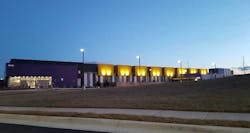New Data Center Designs for Hyperscale Cloud and the Enterprise
In this week’s Voices of the Industry, Bob Woolley, Vice President of Critical Facilities Engineering and Design at RagingWire Data Centers, examines how the data center industry should respond to new design requirements for hyperscale cloud, the enterprise and more.
Bob Woolley, Vice President of Critical Facilities Engineering and Design at RagingWire Data Centers
When building a data center, customer requirements are key. By focusing on the key essential elements of those requirements and understanding the intent of what our customers are looking for, we build facilities that provide everything our customers need, and nothing they don’t.
That last phrase has become our motto, and here is how we execute on that goal.
To save time, money, and deliver a great product, standardize your design
Not long ago, a deployment of a megawatt or two was large. Now we’re commonly seeing hyperscale customers take 8, 10, 16 megawatts at a time, and sometimes much more than that. To meet the needs of our diverse base of hyperscale and enterprise customers, we have to be flexible in our approach, while standardizing everything we can in order to bring down costs through economies of scale and supply chain management.
To be successful in this market, the design must be repeatable using standardized components, while understanding that there will always be site adaptations that have to be made.
Negotiating volume discounts with vendors in the supply chain is also a critical success factor that helps lower costs and can reduce time to market with negotiated lead times for equipment delivery.
Armed with these tools, we can pre-position inventory in our target markets on land that has been prepared with some site and foundation work, with pre-positioned steel or pre-cast that allows us to achieve a 6-9 month delivery time frame.
Adapting and evolving to new customer requirements
So what adaptations have we made in our newest hyperscale-ready designs in order to deliver what the industry is demanding? We are building data centers that are:
Larger – We’re seeing a huge amount of absorption in the industry, so that requires bigger data centers. We’re building in 32 megawatt increments these days, with about 150,000 square feet of white space. We’re building in campus environments that provide greater speed to market and expansion capabilities and connectivity for our clients. Multi-story facilities are becoming more common. This helps increase the yield where the cost of land is high.
Denser – An increase in power density has been happening gradually. Typically we’re looking at 8kW-30kW per rack, although hyperscalers have been known to go above that range, especially in their self-constructed facilities. But if customers need that kind of density, they may have a hard time finding a broad range of possible colocation providers, unless those providers build-to-suit.
Higher Capacity – Historically, we’ve seen data centers utilize far less than their full capacity. But today we’re seeing customers driving their utilization over 90 percent. That makes sense because they would like to maximize the return on their investment, and they have the ability to drive their power consumption to get to that level while maintaining a safety factor. This means that we have to build a facility to perform at full-rated capacity both from a power and cooling perspective, no shortcuts allowed.
Hyperscale cloud deployments are driving the colocation data center market and the design of modern data center facilities.
Lower Total Cost of Ownership (TCO) – Power is the major cost factor that affects TCO in a data center, and advancements in power technology are continuing to emerge. There’s a tendency toward larger block sizes, the UPS’s are getting a little bigger, and the generators are getting a little bigger. This helps when building large facilities because there’s less of an equipment count. So we’re seeing standards today around 2MW for UPS blocks, and 3.0 – 3.25MW generators are pretty common. Power equipment is becoming highly efficient and highly reliable.
Secure – We have to design for a multi-layered physical solution with a focus on the perimeter, while accommodating customer security systems and personnel. By leveraging technology such as drones and camera analytics to monitor, report, and identify suspicious behavior, we can control cost and increase security levels.
Globally Connected – While customizing data centers for local conditions (particularly regional weather, environmental and regulatory parameters), it pays to apply design standards and implement operational processes that can be repeated around the globe. This provides customers with a similar experience no matter where they are doing business.
To summarize, hyperscale cloud deployments are driving the colocation data center market and the design of modern data center facilities. We’re amazed by the scale of this business, but you don’t have to look any farther to explain all that data usage than all the people riding on the train watching videos on their smartphones.
To meet these hyperscale needs, we’re building new data centers with a redundancy, cooling efficiency and a very good PUE (power usage effectiveness), while also being very reliable and deployable in any environment to the scale and the size and the speed that hyperscalers want. In addition to supporting the hyperscalers, our agile design strategies maintain flexibility to support enterprise hybrid computing solutions.
Bob Woolley is Vice President of Critical Facilities Engineering and Design at RagingWire Data Centers.


